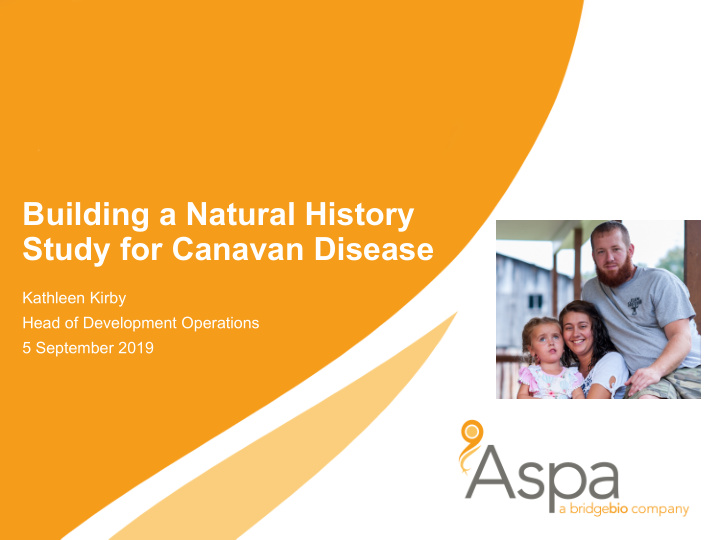



Building a Natural History Study for Canavan Disease Kathleen Kirby Head of Development Operations 5 September 2019
Who What When Where Why Canavan Disease Ultra rare leukodystrophy 1000 patients globally, 1:100,000 births Autosomal recessive Mutations in the ASPA gene, coding for the aspartoacylase enzyme Defect prevents normal myelin from forming Symptoms become most prominent in the first 3 to 5 months of life Early symptoms: severe hypotonia, head lag & macrocephaly, seizures, etc Severe neurologic deterioration leading to profound developmental delay 2
Why is a natural history study needed? Paucity of published data No established endpoints in Canavan No scales / measures that are consistently used Goal: to identify clinically meaningful changes that can be used to establish the necessary endpoint(s) for a treatment trial AND to use the data as a historical control Commitment: Aspa will make data available to researchers 3
Challenges with NH Studies If the study was too burdensome, families would not join If the study was too burdensome, they would withdraw Creative approach to making it as easy as possible Family travel support to site visits Inconsistency across medical records Important to note that and our future treatment trial, while connected by data, are not linked a patient does not need to be enrolled in the natural history study to enroll in the treatment trial and vice versa 4
Unique Aspects of Our Study Record retrieval Data extraction In home assessments (US only) for prospective visits 5
Retrospective Efforts to Date: Prospective Established strong relationships with KOLs / PIs to learn about current management of patients with Canavan disease Patients Advocacy Groups input at all stages Conducted Parent Focus Groups / Interviews to determine what they feel is most important when dealing with Canavan disease 6
Retrospective Efforts to Date: Prospective Contracted with several vendors Consulted with several experts working on similar rare pediatric diseases 7
Retrospective Data: Record Collection Challenges with record retrieval Time consuming & costly Most critical: first 3 years of life Identified Telegenisys & wrote protocol Received IRB approved Record: Hyperlinked, bookmarked Once family receives record, they will be asked to enroll in NH study Upon signing consent, record is transferred to site To date, 15 families have signed up from US & outside EU 8
Data Extraction Challenges with making sense of data across records Link between sign and point on a scale Data Extraction Plan (DEP): defines the steps for extracting data 9
In Home Assessments / Rater Training Extensive Rater training across US and GER raters In person and & on line training modules No Rater will perform an assessment until they have been certified by all qualified trainers US – identified 3 highly qualified Physical Therapists to perform in home assessments (TIMPSI, GMFM, Bayley, HINE2) Extensive support for US Raters as they travel to family homes has been put in place Rater Relatability Testing All Raters begin at the required level Ongoing QC to ensure across prospective data, we maintain high level of quality & consistency 10
Conclusions Don’t under-estimate the effort required to build a natural history study Be prepared for gaps in data – anticipate how you will work through If retrospective, establish not only a solid record retrieval plan but also a plan for how to integrate this with prospective data collection Develop robust plans to collect data in a rigorous way A natural history study is a clinical study – treat it as such 11
Thank You Key Opinion Leaders / PIs Patient Advocates Vendors Consultants Future Families 12
Recommend
More recommend